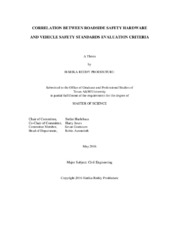| dc.contributor.advisor | Hurlebaus, Stefan | |
| dc.contributor.advisor | Jones, Harry | |
| dc.creator | Prodduturu, Harika Reddy | |
| dc.date.accessioned | 2016-07-08T15:11:15Z | |
| dc.date.available | 2018-05-01T05:49:43Z | |
| dc.date.created | 2016-05 | |
| dc.date.issued | 2016-04-26 | |
| dc.date.submitted | May 2016 | |
| dc.identifier.uri | https://hdl.handle.net/1969.1/156908 | |
| dc.description.abstract | Roadside safety devices are designed to protect vehicle occupants from injuries. As the purpose of roadside safety hardware is to be functional while minimizing the risk of occupant injury, the occupant risk criteria are vital to the assessment of these devices. The “Manual for Assessing Safety Hardware (MASH)”, specifies guidelines for crash tests and gives evaluation criteria for safety devices. As per MASH, the risk of injury to the occupant is assessed based on the concept of “Flail Space Model (FSM). The Occupant Impact Velocity (OIV) and Occupant Ridedown Acceleration (ORA) are used for assessing the injury criteria of an occupant.
It is assumed that the model is an “unrestrained” point mass which can move as a free missile. There is a growing usage of restraints such as seatbelts and airbags. Hence, attempts are made in this study to assess real-world occupant injury risk associated with current MASH criteria using crash tests performed with instrumented ATD’s and comparing them with injury criteria provided by US-NCAP regulations.
A crash test was conducted with a passenger car impacting a rigid wall at 90-degree angle, and with 34.7 mph (56 km/h) impact speed. The vehicle was instrumented according to MASH requirements, and an instrumented ATD was included as required by US-NCAP standards. The full-scale crash test was designed to replicate testing criteria from MASH and US-NCAP testing standards to the maximum possible extent. As per the results from vehicle dynamics, the crash test was found to be a fail according to MASH evaluation criteria but a pass according to US-NCAP standards from ATD dynamics. Therefore a correlation was established between the roadside safety evaluation criteria and occupant injury risk. Additionally, finite element models for a passenger car, passive restraint systems (seatbelt and airbags), and anthropomorphic test ATD were calibrated against this full-scale frontal crash test which can be used for parametric simulations in future with a few modifications. | en |
| dc.format.mimetype | application/pdf | |
| dc.language.iso | en | |
| dc.subject | Manual for Assessing Safety Hardware | en |
| dc.subject | Federal Motor Vehicle Safety Standards | en |
| dc.subject | New Car Assessment Program | en |
| dc.subject | Flail-Space Model | en |
| dc.subject | Crashworthiness | en |
| dc.subject | Anthropomorphic Test Device | en |
| dc.subject | Toyota Yaris | en |
| dc.subject | Finite Element Simulations | en |
| dc.title | Correlation between Roadside Safety Hardware and Vehicle Safety Standards Evaluation Criteria | en |
| dc.type | Thesis | en |
| thesis.degree.department | Civil Engineering | en |
| thesis.degree.discipline | Civil Engineering | en |
| thesis.degree.grantor | Texas A & M University | en |
| thesis.degree.name | Master of Science | en |
| thesis.degree.level | Masters | en |
| dc.contributor.committeeMember | Goenezen, Sevan | |
| dc.type.material | text | en |
| dc.date.updated | 2016-07-08T15:11:15Z | |
| local.embargo.terms | 2018-05-01 | |
| local.etdauthor.orcid | 0000-0002-8815-7525 | |


